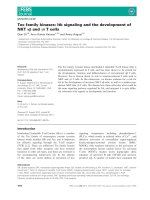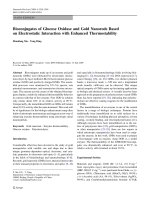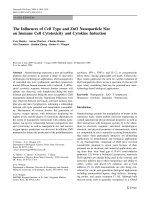Development of ultra sensitive and selective nanoparticle based biosensors
Bạn đang xem bản rút gọn của tài liệu. Xem và tải ngay bản đầy đủ của tài liệu tại đây (3.85 MB, 145 trang )
DEVELOPMENT OF SENSITIVE AND SELECTIVE
NANOPARTICLE-BASED BIOSENSORS
WANG HONGBO
NATIONAL UNIVERSITY OF SINGAPORE
2012
DEVELOPMENT OF ULTRA-SENSITIVE AND
SELECTIVE NANOPARTICLE-BASED BIOSENSORS
WANG HONGBO
(B. S., ZHEJIANG UNIVERSITY)
A THESIS SUBMITTED
FOR THE DEGREE OF DOCTOR OF
PHILOSOPHY
DEPARTMENT OF CHEMISTRY
NATIONAL UNIVERSITY OF SINGAPORE
2012
I
ACKNOWLEGEMENT
This thesis would not have been possible without the generous help of many people
whom I would like to thank here.
First and foremost, I wish to express my deep and sincere gratitude to my supervisor,
Dr. Liu Xiaogang, for giving me the opportunity to study and work under his instruction.
His intelligent guidance, his unreserved support, as well as his encouragement and
assistance repeatedly steered me back from woeful errors and shoddy work throughout
my PhD study. And his conscientious, rigorous and enthusiastic attitude towards research
will deeply impact on my future career and life.
I would like to extend my sincere gratitude to Associate Professor Li Tianhu for his
valuable discussion, warm assistance, and his generous help throughout my graduate
study.
I am also deeply grateful to all the past/current labmates in the Liu group, Wang
Feng, Duan Zhongyu, Zhang Qian, Xu Hui, Sadananda Ranjit, Wang Juan, Xu Wei,
Zhang Wenhui, Su Qianqian, Deng Renren, Xie Xiaoji, Thi Van Thanh Nguyen, Wang
Zongbin, Han Sanyang, Du Guojun, Huang Xiaoyong, Liu Xiaowang, Sun Qiang, Zhang
Yuhai, Tian Jing and Zhang Yuewei. Without their help, this work could not have been
completed on time. I warmly thank Dr. Xu Wei, for teaching me the technical knowledge
and skills at the beginning of my research study. Special thanks to our group’s lab officer
Ma Hui, for her sincere helpfulness during my graduation.
I would like to express my loving thanks to my wife Li Li. Her love, support and
encouragement are important to help me through all the difficulty during my PhD study.
II
Last but not the least, I wish to devote this thesis to my parents for their support and
understanding throughout all my life.
The generous financial support from National University of Singapore is gratefully
acknowledged.
III
Thesis Declaration
The work in this thesis is the original work of Wang Hongbo, performed independently
under the supervision of A/P Liu Xiaogang, (in the laboratory S8-05-12), Chemistry
Department, National University of Singapore, between 04/08/2008 and 03/08/2012.
The content of the thesis has been partly published in:
1) H. Wang , W. Xu , H. Zhang, D. Li, Z. Yang, X. Xie, T. Li , X. Liu , Small 2011, 7,
1987
Wang Hongbo
Wang Hongbo
03-08-2012
Name
Signature
Date
IV
TABLE OF CONTENTS
ACKNOWLEGEMENTS I
THESIS DECLARATION III
SUMMARY VII
LIST OF FIGURES X
LIST OF SCHEMES XV
CHAPTER 1: Introduction…………………………………………………………… 1
1.1 Nucleic acid probes………………………………………………………… 2
1.1.1 Structure of nucleic acids………………………………………………….4
1.1.2 Nucleic acid thermodynamics…………………………………………… 7
1.1.3 DNA damage………………………………………………………… 9
1.2 Nanoparticle transducer…………………………………………………… 10
1.2.1 Typical properties of nanoparticles…………………………………… 12
1.2.2 Gold nanoparticle and surface plasmon resonance…………………… 13
1.2.3 Lanthanide-doped upconversion nanoparticles and multicolor tuning 15
1.3 Integration of Probes and Nanoparticle Transducers……………………… 19
1.3.1 Chemical binding……………………………………………………… 20
1.3.2 Affinity………………………………………………………………… 21
1.3.3 Adsorption…………………………………………………………… 21
1.4 Enzymes………………………………………………………………… … 21
1.4.1 Nuclease……………………………………………………………… 22
V
1.4.2 Phosphatase………………………………………………………… … 23
1.5 Applications of Nanoparticle-based biosensors………………………… … 23
1.5.1 Metal ions…………………………………………………………… ….24
1.5.2 DNAs……………………………………………………………….… 28
1.5.3 Proteins………………………………………………………………… 31
1.5.4 Small organic molecules……………………………………………… 33
1.5.5 Cells…………………………………………………………………… 35
1.6 Reference……………………………………………………………… 38
CHAPTER 2: EcoRI-modified Gold Nanoparticles for Dual-mode Colorimetric
Detection of Magnesium and Pyrophosphate Ions……………………………… 46
2.1 Introduction and Motivation…………………………………………… 46
2.2 Materials and Methods……………………………………………………… 49
2.2.1 Materials……………………………………………………………… 49
2.2.2 Preparation and EcoRI-modification of gold nanoparticles…………… 49
2.2.3 Immobilization of DNA capture strands on glass slides……………… 50
2.2.4 EcoRI-modified gold nanoparticles for Mg
2+
detection……………… 51
2.2.5 Polyacrylamide gel electrophoretic (PAGE) analysis………………… 51
2.2.6 Chip-based magnesium detection…………………………………… 52
2.2.7 Recycling of EcoRI-modified gold nanoparticles…………………… 52
2.2.8 PPi titration…………………………………………………………… 53
2.3 Results and Discussion……………………………………………………… 53
2.4 Summary and Prospect……………………………………………………… 59
VI
2.5 Reference…………………………………………………………………… 64
CHAPTER 3: DNA-Templated Reaction for Pyrimidine Dimer Sensing and
Sunscreen Screening 70
3.1 Introduction and Motivation……………………………………………….… 70
3.2 Materials and Methods……………………………………………………… 71
3.2.1 Reagents and Characterization………………………………………… 71
3.2.2 Immobilization of capture strands on glass slides……………………… 73
3.2.3 Preparation of gold nanoparticle probes……………………………… 74
3.2.4 UV radiation of Target DNA ………………………………………… 74
3.2.5 Chip-based gold nanoparticle-coupled cleavage assay …… 75
3.2.6 Silver enhancement method…………………………………………… 75
3.2.7 Polyacrylamide gel electrophoretic (PAGE) analysis………………… 75
3.3 Results and Discussion……………………………………………………… 76
3.4 Summary and Prospect……………………………………………………… 81
3.5 Reference……………………………………………………………………… 87
CHAPTER 4: Nanoparticle-based Real-Time Colorimetric Assay for Alkaline
Phosphatase with Pyrophosphate as Substrate …… 92
4.1 Introduction and Motivation………………………………………………… 92
4.2 Materials and Methods……………………………………………………… 93
4.2.1 Materials and Instrument………………………………… 93
4.2.2 Preparation of Gold Nanoparticles and MUA-modified Nanoparticles 95
4.2.3 ALP assay…………………………………………………………… 95
VII
4.3 Results and Discussion……………………………………………………… 96
4.3.1 Cu
2+
assay…………………………………………………………… 96
4.3.2 PPi assay…………………………………………………………… … 98
4.3.3 ALP assay…………………………………………………………… 98
4.3.4 Specificity of ALP assay…………………………………………… 101
4.4 Summary and Prospect…………………………………………………… ….101
4.5 Reference…………………………………………………………………… 105
CHAPTER 5: Synthesis of Water-soluble Upconversion Nanoparticles for Cobalt(II)
Detection in the presence of Ethylenediamine…………………………………… 107
5.1 Introduction and Motivation…………………………………………… 107
5.2 Materials and Methods…………………………………………………… 108
6.2.1 Materials and Characterization…………………………………… … 108
6.2.2 Synthesis of β-NaYF4:Yb/Tm Core Nanoparticles……………… …110
6.2.3 Synthesis of NaYF
4
:Yb/Tm@NaYF
4
Core-Shell Nanoparticles… 111
6.2.4 Synthesis of Hydrophilic NaYF
4
:Yb/Tm@NaYF
4
CoreShell NPs 111
6.2.5 Sensing procedure…………………………………………………… 112
5.3 Results and Discussion…………………………………………………… 112
5.4 Summary and Prospect……………………………………………………… 119
5.5 Reference………………………………………………………………… 121
CHAPTER 6: Conclusions and Future Works…………………………………… 126
CURRICULUM VITA…………………………………………………………… …129
VIII
SUMMARY
This thesis depicts research efforts aimed at developing novel biosensors based on
oligonucleotide, small molecules or enzymes functionalized metal nanoparticles, for
ultra-sensitive and selective detection of metal ions, DNA, small organic molecules and
enzymes. In chapter 2, a useful sensor system consisted of EcoRI-modified gold
nanoparticle and DNA sticky end pairing is clarified for colorimetric detection of
magnesium ions (Mg
2+
) and its extended application for pyrophosphate ions (PPi)
determination in aqueous solution. This sensor system can easily detect magnesium ions
and pyrophosphate ions in the presence of excessive other cations and anions respectively.
Compared with instrument-based identification methods, this instrument-free assay
possesses advantages of rapid screening and recycles use. In chapter 3, a chip-based
platform using oligonucleotide-modified gold nanoparticles and silver amplification, for
fast determination the effectivity of sunscreen against UV light is investigated. This
platform could offer the ability to quickly distinguish the effectivity of various
commercial sunscreens under the irradiation of UV light. In chapter 4, a real-time
colorimetric method, based on mercaptoundecanoic acid (MUA)-modified nanoparticles,
cupric ion and the enzyme’s natural substrate PPi, to detect the activity of alkaline
phosphatase is presented. The particle system shows high selectivity and excellent
stability, which should enable a broad spectrum of potential applications in the
monitoring and detection for pyrophosphate ions and phosphatase in complex settings. In
chapter 5, on the basis of upconverted luminescence resonance energy transfer, a
platform for fast screening of cobalt ions in the presence of ethylenediamine in aqueous
IX
solutions using acid-capped upconversion nanoparticles is developed. This new optical
detection approach would provide an opportunity for simultaneous sensing of multiplex
metals ions in future.
X
LIST OF FIGURES
Figure 1.1 Scheme illustrating the basic design of NP-based biosensors 3
Figure 1.2 Schematic diagram of the structure of duplex DNA……………………… 6
Figure 1.3 Direct DNA damage: The UV-photon is directly absorbed by the DNA (left).
One of the possible reactions from the excited state is the formation of a thymine-thymine
cyclobutane dimer (right)…………………………………………………………….… 11
Figure 1.4 (a) Scheme for localized surface plasmon resonance of gold nanoparticles. (b)
The UV-vis spectrum and images of dispersed and aggregated gold nanoparticles… 16
Figure 1.5 Structure and optical properties of Ln-doped UC nanoparticles. (a) Schematic
illustration of UC nanoparticles composed of a crystalline host and lanthanide dopant
ions embedded in the host lattice. (b) Schematic energy level diagram showing that UC
luminescence primarily originates from electron transitions between energy levels of
localized dopant ions. (c) Typical emission spectra showing multiple narrow and
well-separated emissions produced by cubic NaYF
4
:Yb/Tm (20/0.2 mol%) and NaYF
4
:
Yb/Er (18/2 mol%) nanoparticles. (d) UC multicolor fine-tuning through the use of
lanthanide-doped NaYF
4
nanoparticles with varied dopant ratios. Note that the emission
spectra and colors are associated with the host composition, particle size, and particle
surface properties……………………………………………………………………… 18
Figure 1.6 Properties of DNA/GNP-based sensor. In the presence of complementary
target DNA a’b’, gold nanoparticles are reversibly aggregated, resulting in a change of
solution color from red to blue. A sharp melting transition can be founded via UV-vis
spectrum……………………………………………………………………………… 25
Figure 1.7 Schematic of the Hg
2+
detection by using 14 nm NPs with oligonucleotide
modification that forms a sandwich DNA structure with seven T-T
mismatches ………………………………………… 27
Figure 1.8 Chip-based DNA detection by the amplification of Silver ion reduction 30
Figure 1.9 Schematic Illustration for the LRET Process between NaYF
4
:Yb, Er UCNPs
(Donor) and gold NPs (Acceptor)……………………………………………………… 32
Figure 1.10 Specific structure of aptamer for a small molecule…………………… 34
XI
Figure 1.11 Schematic representation of the synthesis of monoclonal anti-HER2
antibody and S6 RNA aptamer-conjugated oval-shaped gold nanoparticles and
multifunctional oval-shaped gold-nanoparticle-based sensing of the SK-BR-3 breast
cancer cell line……………………………………………………………………….… 37
Figure 2.1 UV-vis spectra of solutions corresponding to the as-synthesized
citrate-capped gold nanoparticles, MUA-modified particles, and EcoRI-modified
particles, respectively…………………………………………………………………….54
Figure 2.2 Colorimetric detection of Mg
2+
. (a) Color response of a 14-nm nanoparticle
detection system (~4 nM particles; 0.3 μM DNA duplex) in the presence (5 μM) or
absence of Mg
2+
. (b) The corresponding UV-Vis spectra of the particle solutions with or
without Mg
2+
. (c, d) The corresponding TEM images taken for the samples with and
without Mg
2+
. (e) Colorimetric response of the detection system (~4 nM particles; 0.3 μM
DNA duplex) in the presence of a selection of metal ions (10 μM each)…………….….56
Figure 2.3 (a) Top: scanometric images taken after silver enhancement of the
DNA-modified glass slide incubated with EcoRI-modified nanoparticles in the presence
of various concentrations of Mg
2+
(0, 0.1, 1, 10, and 100 μM). Bottom: the corresponding
grayscale values of darkened areas obtained as a function of Mg
2+
concentration. (b)
Autoradiogram of polyacrylamide gel-separated products obtained from DNA cleavage
experiments using EcoRI-modified nanoparticles stored for different periods of time
(Lane 1: control experiment without the addition of EcoRI-modified nanoparticles). (c)
UV-vis spectra of the recycled particle solutions for the redispersed EcoRI-modified
nanoparticles (solid lines) in comparison to particle aggregation (dashed lines)…….….60
Figure 2.4 (a) Colorimetric response of the detection system (~4 nM particles; 0.3 μM
DNA duplex) in the presence of various PPi contents (0-30 μM). (b) The corresponding
UV-Vis spectra of the particle solutions in the presence of different PPi concentrations. (c)
Top: colorimetric response of the particle solutions containing different anions. Bottom:
the corresponding UV-vis absorption ratio of the particle solution at 565 to 525 nm as a
function of different anion (50 μM each)…………………………………………….….62
Figure 2.5 UV-vis spectra obtained for solutions containing the EcoRI-modified particle
system (~4 nM nanoparticles; 0.3 µM duplex), magnesium ions (5 µM), and various
anions (50 µM each)…………………………………………………………………… 63
Figure 3.1 Scanometric images of oligonucleotide-modified glass slides after gold
nanoparticle-coupled DNA-templated reactions in the presence of various target DNAs
(top). The corresponding grayscale values of darkened areas are reported below each
XII
panel (bottom). Lane 1: DNA-templated reactions without the addition of target DNA
containing dimers and T4 PDG; Lane 2: with the addition of T4 PDG but no dimer in
target DNA; Lane 3: with the addition of target DNA containing dimers but without T4
PDG; Lane 4: with the addition of target DNA containing dimers and T4
PDG ……………………………………………………………………………… 78
Figure 3.2 Gel electrophoresis analysis of various target DNAs. Lane 1: DNA-templated
reactions without the addition of target DNA containing dimers and T4 PDG; Lane 2:
with the addition of T4 PDG but no dimer in target DNA; Lane 3: with the addition of
target DNA containing dimers but without T4 PDG; Lane 4: with the addition of target
DNA containing dimers and T4 PDG ………… 79
Figure 3.3 Evaluation of the protective effect of sunscreen against UV irradiation. A
representative scanometric image of oligonucleotide-modified glass slide after gold
nanoparticle-coupled DNA-templated reactions in the presence of various target DNAs
which are treated with or without sunscreen (top). The corresponding grayscale values of
darkened areas are reported below each panel (bottom) …… 82
Figure 3.4 Gel electrophoresis analysis of various target DNA strands irradiated by UV
in the presence and absence of sunscreen after T4 PDG treatment … 83
Figure 3.5 Evaluation of the protective effect of different creams against UV irradiation.
A representative scanometric image of oligonucleotide-modified glass slides after gold
nanoparticle-coupled DNA-templated reactions in the presence of various target DNAs
which are treated with different kinds of cream (top). The corresponding grayscale values
of darkened areas are reported below each panel (bottom) ……………………… 84
Figure 3.6 Gel electrophoresis analysis of various target DNA irradiated by UV in the
presence different kinds of creams after T4 PDG treatment ……………………… 85
Figure 3.7 Color responses of probe solutions for targets with various UV irradiated time
in the presence of T4 PDG at room temperature……………………………………… 86
Figure 4.1 (a) Color response of a 14-nm nanoparticle detection system (~2 nM particles)
in the different concentration of Cu
2+
(0, 25, 50, 75 μM). (b) The corresponding UV-Vis
spectra of the particle solutions……………………………………………………… 97
Figure 4.2 (a) UV-Vis spectra of the detection system (~2 nM particles; 50 μM Cu
2+
; 40
μM PPi) in the presence of various cations (50 μM). (b) Top: colorimetric response of the
particle solutions containing different cations. Bottom: the corresponding UV-vis









